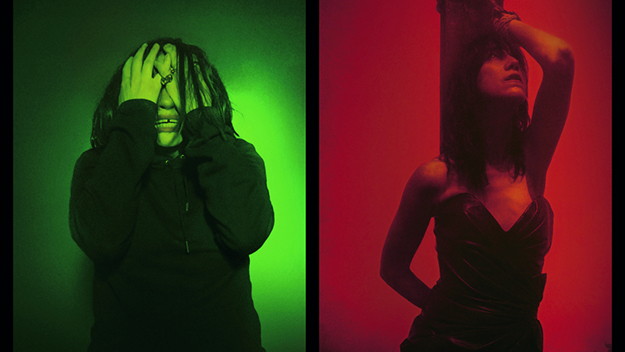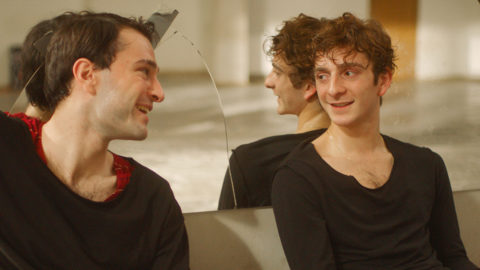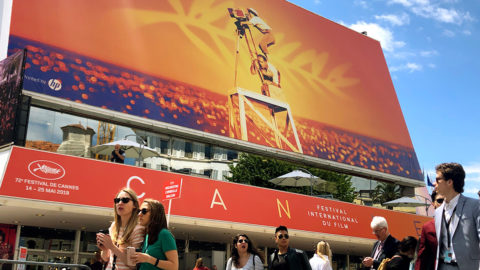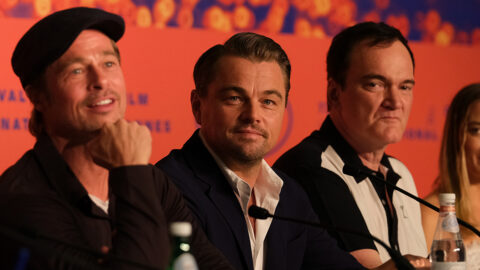Cannes Dispatch: Gaspar Noé

Lux Aeterna (Gaspar Noé, 2019)
Following the mesmerizing final moments of Gaspar Noé’s new, 51-minute Lux Aeterna here at the Cannes Film Festival, I was surprised to immediately encounter the director himself. Not onstage, but alone in the audience.
I was seated in the back row of the theater and had watched the film all the way through the credits. As I stood to leave, I realized that Noé was behind me. He had apparently been standing and filming the screen and audience with a small camera. I exited the cinema alongside Noé and when we got out into the bright sunlight I turned to greet him, and he responded warmly as I asked him about the origins of this new film. Smiling broadly and seeming a bit giddy, Noé said that he had made the film a month and a half ago.
Lux Aeterna had started as an even shorter movie, but it expanded quickly. Shot in a widescreen format that intermittently divides the screen into thirds, the film sometimes shows the same scene from multiple vantage points at once. Set during the troubled production of a film, the story captures the battle between a volatile director and a producer trying to either sabotage or take control of the movie, and depicts a group of actors pushed beyond their limits. The film climaxes in a brightly colored triptych of writhing, struggling witches burned at the stake, for perhaps as long as 10 minutes, as ear piercing sounds and pulsating, strobe-like images transfix the viewer—a thrilling and unforgettable endurance test.
The film began in February when Noé received a call from Anthony Vaccarello, artistic head of fashion house Saint Laurent, asking if he’d like to collaborate; 10 days later Noé had an idea and accepted. Lux Aeterna is one of two medium-length, fashion-fueled productions showing in Cannes, the other being Luca Guadagnino’s collaboration with fashion house Valentino. While Guadagnino’s beautifully shot, luxurious, Italy-set short feels like a fashion show brought to life, Noe’s is something else entirely.
Said Noé at the press conference, the concept was the “shooting of a film that doesn’t work out very well.” He also had a notion to explore the history of religion. “I wanted to make it a horror movie, and then something weird happened: people started to be funny. The movie becomes itself because of the people who are involved, but I never expected to do a funny movie.”
Even though Noé found the idea for his film quickly, he relied on his actors, including Charlotte Gainsbourg and Béatrice Dalle (who wear the house’s fashions in the film), to help him shape the narrative. Cameras follow actors around the troubled, dark film set and eavesdrop on their conversations and confrontations as they prepare to shoot a difficult scene.
“There were lots of rushes and improvised dialogue,” Noé said, adding that he had enough footage to make it into a feature if he wanted. “Sometimes we envy directors of documentaries, but why imitate life? Why not just enjoy making a film, have fun. Ask people if they have any ideas and you come up with extraordinary things at the last minute.”
The unstructured production was hardly daunting for Noé’s cast. “I would have loved it to last six months and not five days,” said Dalle. “I could have shot and acted for longer. We had lots of freedom,” Gainsbourg concurred. Noé noted, “I place full trust in actors or actresses. If you have too much dialogue then the film doesn’t work out exactly how you want. What you don’t want is for people to follow a blueprint in a cold, thinking way.”
Lux Aeterna includes a number of on-screen quotes, including by Jean-Luc Godard, Rainer Werner Fassbinder, and Dostoevsky. “He [Dostoevsky] says that he never met a higher pleasure than having an epileptic fit,” Noé explained. “So I felt we could offer an epileptic fit to the audience.” With this the director seemed to justify his final sequence of sensory overload, and perhaps also his visit to voyeuristically film the crowd at the film’s second Cannes screening. “I love flickering images,” Noé continued, “I did a lot of music videos with flickering effects. It was Godard who said that cinema is truth 24 frames per second, but mostly it’s not truth because movies are all fake. But it’s light 24 frames per second and I love strobe lights. When you go to a club without strobe lights it doesn’t feel the same.”
Noé maintained that it’s the alluring aspects of the cinematic experience that draw audiences to festivals and cinemas. “People like going to see movies because they want to dream. Dreams don’t happen every night in real life, but you are addicted to the dream state so, if you are all here for the Cannes Film Festival, it’s because you want to dream big and share the dreams with other people. And there is something about the flickering lights that puts you in a strange state that reminds you of taking psychedelics.”
Noé continued, “There are so many more things to do with the cinematic language that haven’t been done, and that’s why I don’t really think that all of these TV series and over-scripted stories, made into movies, help to enjoy cinema for what it should be. Cinema is much bigger; it’s a great language.” Noé mentioned his own inspirations, calling out the films of Paul Sharits, Tony Conrad, Jordan Belson, and Kenneth Anger, adding, “Some people go to museums to see paintings and some people can go to an experimental film festival just to see flickering lights. They put me in a dream state and I can watch those movies over and over even if they don’t have actors even if they don’t have anything else other than lights. They are totally hypnotic.”
Near the end of the press conference, a journalist asked if he might want to adopt a more conventional approach for a future film. He didn’t get a chance to reply because Dalle jumped in to answer: “I have never seen a conventional film made by Gaspar Noé.”
Eugene Hernandez is Deputy Director of Film at Lincoln Center and Co-Publisher of Film Comment.






